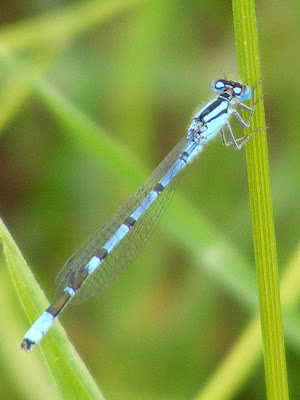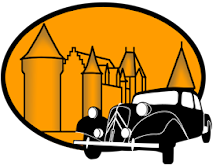Scientific Name: Enallagma cyathigerum.
English Name: Common Bluet or Common Blue Damselfly.
French Name: L'Agrion porte-coupe (='the cup-bearing blue damselfly')
 5 Key Characters:
5 Key Characters:
Habitat: Still water of all sorts (ponds, ditches, étangs, lakes, artificial pools, bogs, dams) and slow rivers. Unlike other bluets they prefer open water and can be seen in large numbers far from the bank.
Flight Period: April-May-June-July-August-September-October.
Status: Common and widespread. A species that has benefitted from man's pond and dam building activities.
Photographed by Loire Valley Nature:
Photographs are numbered from left to right and top to bottom. All photos will enlarge in a new window if you click on them. 1 - 3 & 7 a mating pair (male above female) on the Claise River at Preuilly, May. 4 - 6 male in improved pasture in the Brenne, May.
English Name: Common Bluet or Common Blue Damselfly.
French Name: L'Agrion porte-coupe (='the cup-bearing blue damselfly')
 5 Key Characters:
5 Key Characters:- males have a black marking on the second abdominal segment described variously as shaped like a stemmed cup, a mushroom or a golf ball on a tee.
- the lateral suture (the junction between two exoskeletal plates on the thorax) has very little trace of black, so the sides of the thorax are plain blue.
- females have torpedo shaped black marks along the top of the abdomen, with segment 8 in the form of a triangle or arrow head surrounded by blue.
- the blue 'shoulder' stripes (antehumerals) are thick - at least as wide and usually wider than black humeral stripe below them.
- abdominal segments 8-9 are completely blue in the males, forming a 'tail light'.
Habitat: Still water of all sorts (ponds, ditches, étangs, lakes, artificial pools, bogs, dams) and slow rivers. Unlike other bluets they prefer open water and can be seen in large numbers far from the bank.
Flight Period: April-May-June-July-August-September-October.
Status: Common and widespread. A species that has benefitted from man's pond and dam building activities.
Photographed by Loire Valley Nature:
Photographs are numbered from left to right and top to bottom. All photos will enlarge in a new window if you click on them. 1 - 3 & 7 a mating pair (male above female) on the Claise River at Preuilly, May. 4 - 6 male in improved pasture in the Brenne, May.













No comments:
Post a Comment